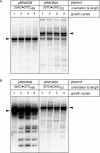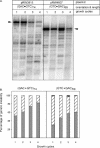Transcription influences the types of deletion and expansion products in an orientation-dependent manner from GAC*GTC repeats
- PMID: 15317871
- PMCID: PMC516059
- DOI: 10.1093/nar/gkh787
Transcription influences the types of deletion and expansion products in an orientation-dependent manner from GAC*GTC repeats
Abstract
The genetic instability of (GAC*GTC)n (where n = 6-74) was investigated in an Escherichia coli-based plasmid system. Prior work implicated the instability of a (GAC*GTC)5 tract in the cartilage oligomeric matrix protein (COMP) gene to the 4, 6 or 7mers in the etiology of pseudoachondroplasia and multiple epiphyseal dysplasia. The effects of triplet repeat length and orientation were studied after multiple replication cycles in vivo. A transcribed plasmid containing (GAC*GTC)49 repeats led to large deletions (>3 repeats) after propagation in E.coli; however, if transcription was silenced by the LacI(Q) repressor, small expansions and deletions (<3 repeats) predominated the mutation spectra. In contrast, propagation of similar length but opposing orientation (GTC*GAC)53 containing plasmid led to small instabilities that were unaffected by the repression of transcription. Thus, by inhibiting transcription, the genetic instability of (GAC*GTC)49 repeats did not significantly differ from the opposing orientation, (GTC*GAC)53. We postulate that small instabilities of GAC*GTC repeats are achieved through replicative slippage, whereas large deletion events are found when GAC*GTC repeats are transcribed. Herein, we report the first genetic study on GAC*GTC repeat instability describing two types of mutational patterns that can be partitioned by transcription modulation. Along with prior biophysical data, these results lay the initial groundwork for understanding the genetic processes responsible for triplet repeat mutations in the COMP gene.
Figures







Similar articles
-
Modulation of transcription reveals a new mechanism of triplet repeat instability in Escherichia coli.J Mol Biol. 2001 Mar 16;307(1):39-49. doi: 10.1006/jmbi.2000.4489. J Mol Biol. 2001. PMID: 11243802
-
Trinucleotide expansion mutations in the cartilage oligomeric matrix protein (COMP) gene.Hum Mol Genet. 1999 Jan;8(1):123-8. doi: 10.1093/hmg/8.1.123. Hum Mol Genet. 1999. PMID: 9887340
-
Novel and recurrent COMP (cartilage oligomeric matrix protein) mutations in pseudoachondroplasia and multiple epiphyseal dysplasia.Hum Genet. 1998 Dec;103(6):633-8. doi: 10.1007/s004390050883. Hum Genet. 1998. PMID: 9921895
-
Advances in mechanisms of genetic instability related to hereditary neurological diseases.Nucleic Acids Res. 2005 Jul 8;33(12):3785-98. doi: 10.1093/nar/gki697. Print 2005. Nucleic Acids Res. 2005. PMID: 16006624 Free PMC article. Review.
-
Mechanisms of tandem repeat instability in bacteria.Mutat Res. 2006 Jun 25;598(1-2):144-63. doi: 10.1016/j.mrfmmm.2006.01.020. Epub 2006 Mar 7. Mutat Res. 2006. PMID: 16519906 Review.
Cited by
-
The genome-wide determinants of human and chimpanzee microsatellite evolution.Genome Res. 2008 Jan;18(1):30-8. doi: 10.1101/gr.7113408. Epub 2007 Nov 21. Genome Res. 2008. PMID: 18032720 Free PMC article.
-
Xpa deficiency reduces CAG trinucleotide repeat instability in neuronal tissues in a mouse model of SCA1.Hum Mol Genet. 2011 Dec 15;20(24):4822-30. doi: 10.1093/hmg/ddr421. Epub 2011 Sep 15. Hum Mol Genet. 2011. PMID: 21926083 Free PMC article.
-
The mismatch repair protein MSH2 is rate limiting for repeat expansion in a fragile X premutation mouse model.Hum Mutat. 2014 Jan;35(1):129-36. doi: 10.1002/humu.22464. Hum Mutat. 2014. PMID: 24130133 Free PMC article.
-
Double-strand breaks in the myotonic dystrophy type 1 and the fragile X syndrome triplet repeat sequences induce different types of mutations in DNA flanking sequences in Escherichia coli.Nucleic Acids Res. 2006;34(19):5369-82. doi: 10.1093/nar/gkl612. Epub 2006 Sep 29. Nucleic Acids Res. 2006. PMID: 17012280 Free PMC article.
-
Transcription destabilizes triplet repeats.Mol Carcinog. 2009 Apr;48(4):350-61. doi: 10.1002/mc.20488. Mol Carcinog. 2009. PMID: 18973172 Free PMC article. Review.
References
-
- Wells R.D. and Warren,S.T. (eds) (1998) Genetic Instabilities and Hereditary Neurological Diseases. Academic Press, San Diego, CA.
-
- Cummings C.J. and Zoghbi,H.Y. (2000) Trinucleotide repeats: mechanisms and pathophysiology. Annu. Rev. Genomics Hum. Genet., 1, 281–328. - PubMed
-
- Delot E., King,L.M., Briggs,M.D., Wilcox,W.R. and Cohn,D.H. (1999) Trinucleotide expansion mutations in the cartilage oligomeric matrix protein (COMP) gene. Hum. Mol. Genet., 8, 123–128. - PubMed
-
- Ohshima K., Kang,S. and Wells,R.D. (1996) CTG triplet repeats from human hereditary diseases are dominant genetic expansion products in Escherichia coli. J. Biol. Chem., 271, 1853–1856. - PubMed
Publication types
MeSH terms
Substances
Grants and funding
LinkOut - more resources
Full Text Sources
Miscellaneous

